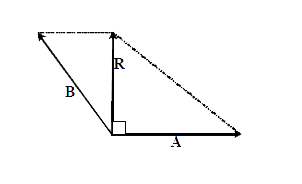The sum of two vectors A and B is at right angles to their difference. Then
A=B
A=2B
B=2A
A and B have the same direction
The correct Answer is:A
To solve the problem, we need to analyze the given condition that the sum of two vectors A and B is at right angles to their difference.
1. Understanding the Condition:
We are given that:
A+B⊥A−B
This means that the dot product of these two vectors is zero:
(A+B)⋅(A−B)=0
2. Expanding the Dot Product:
We can expand the left-hand side using the distributive property of the dot product:
A⋅A−A⋅B+B⋅A−B⋅B=0
Since A⋅B=B⋅A, we can simplify this to:
|A|2−|B|2=0
3. Setting Up the Equation:
From the equation |A|2−|B|2=0, we can rearrange it to:
|A|2=|B|2
This implies that the magnitudes of the vectors are equal:
|A|=|B|
4. Conclusion:
The equality of magnitudes means that the two vectors can be equal, i.e., A=B or they can be equal in magnitude but opposite in direction, i.e., A=−B. However, since we are looking for the options provided in the question, the only option that is definitively true is:
A=B
Final Answer:
The correct option is:
- Option 1: A=B
We are given that:
A+B⊥A−B
This means that the dot product of these two vectors is zero:
(A+B)⋅(A−B)=0
We can expand the left-hand side using the distributive property of the dot product:
A⋅A−A⋅B+B⋅A−B⋅B=0
Since A⋅B=B⋅A, we can simplify this to:
|A|2−|B|2=0
From the equation |A|2−|B|2=0, we can rearrange it to:
|A|2=|B|2
This implies that the magnitudes of the vectors are equal:
|A|=|B|
The equality of magnitudes means that the two vectors can be equal, i.e., A=B or they can be equal in magnitude but opposite in direction, i.e., A=−B. However, since we are looking for the options provided in the question, the only option that is definitively true is:
A=B
The correct option is:
- Option 1: A=B
Topper's Solved these Questions
- VECTORSBOOK - DC PANDEY ENGLISHCHAPTER - VECTORSEXERCISE - Subjective
24 Videos
- VECTORSBOOK - DC PANDEY ENGLISHCHAPTER - VECTORSEXERCISE - Example
40 Videos
- VECTORSBOOK - DC PANDEY ENGLISHCHAPTER - VECTORSEXERCISE - Exercise 5.3
4 Videos
- UNITS, DIMENSIONS & ERROR ANALYSIS BOOK - DC PANDEY ENGLISHCHAPTER - UNITS, DIMENSIONS & ERROR ANALYSIS EXERCISE - Medical entrances gallery
32 Videos
- WAVE MOTIONBOOK - DC PANDEY ENGLISHCHAPTER - WAVE MOTIONEXERCISE - Integer Type Question
11 Videos
Similar Questions
The resultant of two vector A and B is at right angles to A and its magnitude is half of B. Find the angle between A and B.
View SolutionTwo vectors →Aand→B are at right angles to each other then
View SolutionThe magnitude of the sum of two vectors is equal to the difference in their magnitudes. What is the angle between vectors?
View SolutionIf the sum of two unit vectors is a unit vector, then magnitude of difference is-
View SolutionThe sum of two angles of a triangle is 800 and their difference is 200. Find all the angles.
View SolutionThe sum of two angles of a triangle is 800 and their difference is 200 . Find all the angles.
View SolutionThe resultant of two vectors at right angles is 5 N. If the angle between them is 120∘ and the resultant is √13 then the magnitude of vectors are
View SolutionThe resultant of two vectors A and B is perpendicular to the vector A and its magnitude is equal to half the magnitude of vector B. The angle between A and B is -

View SolutionThe maximum and minimum magnitudes of the resultant of two vectors are 23 units and 7 units respectively. If these two vectors are acting at right angles to each other, the magnitude of their resultant will be
View SolutionThe maximum and minimum magnitudes of the resultant of two vectors are 23 units and 7 units respectively. If these two vectors are acting at right angles to each other, the magnitude of their resultant will be
View Solution
